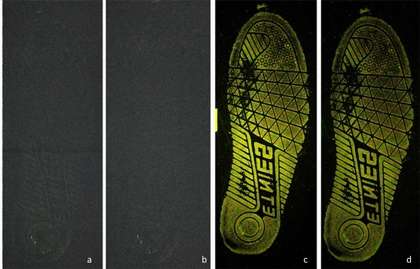Shoeprints recovered from crime scene clothing in forensic science first

(Phys.org)—A set of revolutionary new techniques that make it possible to recover invisible prints left on fabric by the sole of a person's shoe, have been developed by scientists at the University of Abertay Dundee.
Last year, researchers at the University made the headlines when they recovered latent (or invisible) fingerprints from fabrics for the very first time.
The recovery of latent footwear marks, however, had been something of a pipedream - until now.
By adapting and modifying existing print visualisation techniques, Dr Kevin Farrugia has developed the world's first detailed images of latent footwear marks left on fabrics.
The information these provide will enable police to identify perpetrators of serious crimes in cases where, for example, no fingerprints or DNA can be recovered from the scene.
Dr Farrugia explains:
"Footwear marks can be made in many contaminants, for instance blood, mud, urine and dust. They can be left on all sorts of different fabrics, like cotton or denim, as well as on patterned and dark material, which makes them more difficult to see.
"They might be left on the body of a murder victim if the perpetrator kicked or stamped on them during an attack, or they might be made by traces of blood that the perpetrator picked up on their shoes and left on the carpet, or other types of flooring, before leaving the victim's house.
"When someone steps in wet blood though, the first few prints they leave will be a wet smudge, so no fine detail from the footwear sole can be recovered.
"However, as the marks fade and becomes less visible, the pattern on the sole of the shoe, by contrast, becomes much clearer and better defined. And it's these prints - the ones that we can't actually see - that are the most useful at a crime scene, especially when it isn't possible to recover other types of evidence such as fingerprints and DNA, because they can tell you things like what size, and even what brand, of shoe the perpetrator was wearing when they committed the crime.
"More importantly, because everyone walks differently, the sole of their shoes will have acquired what we call random and individual characteristics that are specific to that shoe and person, which means, when the police have got a suspect, they can get their shoes, and if the shoes match, it can lead to a conviction."
Over the years, previous attempts to recover footwear marks from fabrics had generally obliterated, rather enhanced, the image, because the right mix of the right types of chemicals had never been formulated.
No one thought it would ever be possible to recover shoeprints from fabrics, and it was not an active area of research until funding from the Home Office, the Engineering and Physical Sciences Research Council (EPSRC) and the University of Strathclyde became available.
Dr Farrugia's new techniques bring the print to the fore without damaging it, and produce a clear and highly detailed image, for the very first time.
They work on fresh prints, as well as older ones, and could potentially be used to help solve cold cases as well as new ones.
Dr Farrugia's research was carried out at the University of Strathclyde, under the supervision of Professor Niamh Nic Daéid, where he was awarded his PhD.
Since joining Abertay, Dr Farrugia has written a set of guidelines that explain which technique should be used for which contaminant, on which type of material.
These have been published as a series of papers in the mainstream forensic science journal Forensic Science International and the UK Forensic Science Society's journal Science and Justice.
Journal information: Forensic Science International
Provided by University of Abertay Dundee


















